‘FOUR WAY’, ‘FOLDING LENS’ or ‘SPLIT LENS’ TYPE
1900s Motoring and Early World War I Flying Goggles, World War II Japanese Type 5 Dust Goggles, WWII Russian Tank Goggles, Chinese Tank Goggles, RAF Split Lens &etc.
This goggle type has its roots in France, with most references relating them to ‘early French types’. The earliest advertisement sighted for this kind is dated 1904. They may have been a development of the 19th century ‘Railway Spectacle’ with protective glass side panels (Fig. 3). They could be folded into a very compact shape and allowed good peripheral vision.
They were popular with Edwardian motorists and pre and early World War I aviators. They became standard Japanese Army and Navy Landing Force Type 5 dust goggles throughout the 1930s and WWII. This metal hinged Japanese version with its neat case appears to be the basis for the Type 59 Chinese general purpose and tank goggles produced through the 1960s to 1975. From 1934 Russian motorised troops, from motorcyclists to tank crews were issued with a heavy leather version of the type, which with the exigencies of war was rapidly replaced with artificial leather during the Second World War. Post WWII cheaper light leatherette versions were mass produced in the Soviet Block to be used by government workers and sold to the general public. With their good peripheral vision it is said the design inspired the WWII RAF split lens types. Their general use in Edwardian times and during WWI; later adoption by various armed forces; and then mass production during the Soviet era in both Eastern Europe and China means there are some very rare versions, and some very common ones.

Figure 3. They were probably a logical development of the nineteenth century ‘railway glasses’. Designed to protect the eyes from smoke, ash and cinders in open carriages. Similar types were worn by artillerymen in the Crimean and American Civil War. At right is an early WWI mask-less pair of split-lens goggles/spectacles
1900s to the end of WWI
The goggles initial hay-day was the period of the 1900s up until early WWI. Numerous advertisements for the type appear in European and American magazines and catalogues during that period. Evidence would suggest that versions were made in France, Germany, Britain and the United States and probably elsewhere. In the few years before WWI the aviation world was small and comradely, although very competitive, with air shows and competitions being regularly held throughout Europe (mainly France and Germany) and America. At such events the clothing and accessories of notable pilots were perused and subsequently bought. So at the commencement of WWI aviators were tending to wear similar equipment; French goggles and flying helmets were popular universally. During WWI, however, more robust, nationally distinctive goggles types were designed by the various belligerent countries and these tended to eclipse these pre-war lightweight Edwardian types.

Figure 4. Left, an Edwardian pair (1901-1910), with thin brass frames, and the ‘hinge’ is part of the kid leather mask. Probably French as it has an embossed fleur-de-lis on the slider. The leather often came with a green silk backing. Right, a WWI era version, nickel plated steel, with metal hinge. This pair has ‘KM’ on the strap buckle/slider, and is thought to be German. (Compare with Fig. 6, bottom right)

Figure 5. Their foldable nature meant they could be carried in a very compact case. Here a reinforced pressed card version, which could easily fit in even a modest sized pocket. The same case design can be found with the Imperial German ‘DRGM’ registration and the French ‘Brevet’ patent marks.

Figure 6. Pre-WWI advertisements for versions of the type, being from retail stores etc, these may be imports. Top left, New York’s Macy’s catalogue, 1904; top right and middle left, Sak’s catalogue, New York, 1905. Middle right, 1910, National Auto Supply Company, New York; bottom left, 1913 British advertisement (William Whitley Ltd), bottom right, 1915 U.S. (B.A.&CO. Chicago). Note, that both the middle and bottom right advertisements, although 5 years apart have the same image, they show a patented metal hinge, others relied on cloth hinges.

Figure 8. In the early part of WWI they were used by all nationalities, but seemed especially popular with German pilots. Manfred Von Richthofen (second left) as well as more standard goggle types, often wore a version of the split lens type. However, with the leather/fabic mask being a structural element they would tend to collapse at high wind speeds and other goggle types became more practical in the air as the war progressed.
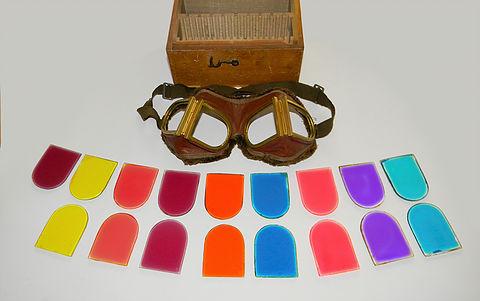
Figure 9. WWI British, Royal Naval Air Service, specialist goggles with numerous different coloured lenses used for signal flare enhancement. These had strong brass frames to withstand repeated lens changes, and had a thick fur trim to the back of the leather mask.

Figure 10. The stronger; nationally distinctive goggles, which tended to be used in the last couple of years of WWI. Although pilots still had the freedom to wear whatever they felt comfortable with, these tended to dominated certain air forces. a) the RFC/RAF Mk I & Mk II goggle mask. b) the French Meyrowitz goggles. c) German ‘Standard Goggles’, developed from a French design. d) U.S. Resistal NAK goggles developed from British designs. The U.S. also used the RAF and Meyrowitz goggles in large numbers whilst their manufactures tooled up.
Due to the advantages mentioned above the split lens types did remain popular post-WWI as lightweight handy goggles for the amateur motorist. Also due to their good peripheral vision and ability to be folded and slipped into a pocket, they were later chosen as dust goggles by the military of several nations.
The Japanese Versions
A notable military user was the Japanese Army and Navy, through the 1920s until the end of WWII. They were used as early aviation goggles and from 1930, as military ‘Dust Proof Glasses’.

Figure 11. Japanese Type 5 ‘Dust Proof Glasses’. The earliest versions appear to have been leather and nickel plate/chrome; later versions leatherette (fake-leather) and finally plain, but fine quality canvas, these later ones had non-reflective paint. Middle left; a 1930s leatherette and chrome pair, (middle right) leatherette, but with painted frames, late 1930s early WWII? (Bottom). The War-time version, light khaki canvas face mask, khaki painted frames. Note; metal mortise hinges on all.
In the early 1920s the Japanese Imperial Army Air Force procured much equipment of French origin. It is possible that examples of the type arrived then. In the early 1920s they were used as aviator’s goggles, these appear to have been leather masked with nickel or chromed plated frames. The most common use of the type, however, was from 1930 as general purpose dust goggles for ground troops. They were designated ‘Dust Proof Glasses’ (防塵眼鏡 ‘Bōjin Megane’) Type 5 (1930 = fifth year of Hirohito’s reign = Showa year 5). The later military ‘Dust Proof Glasses’ had khaki painted frames and the mask seems to have evolved through time, with early ones made of leatherette and wartime production being a high quality lightweight pale khaki canvas. There are numerous pictures of them being used by troops in the dusty environments of central Asia during the 1930’s and elsewhere in WWII. Although from 1930 Japanese tank crews had their own special laminated ‘Armoured’ goggles based on the British Triplex ‘Featherweights’ of WWI, non-armoured land transport troops, dispatch riders and ground troops used these lightweight folding lens Type 5 dust goggles through the 1930s to the end of WWII.

Figure 12. Japanese armoured vehicle driver in the Philippines wearing Type 5 dust goggles. They were not however, issued as specialist Tank Goggles, but were for general purpose.
These were originally Army issue, but when Naval Landing Forces started routinely operating on land, they adopted these Army goggles as well as several other items of ground troop equipment. Examples of early leather flight pairs are marked ‘Yamamoto Manufacturing, Iwatani’. The Type 5 Dust Goggle was usually issued in a small, neat, thick leather pouch with a rear loop for threading onto a belt, either shut with a tongue and loop closure, or a snap fastener.

Figure 13. A development sketch of the Type 5 ‘Dust Proof Glasses’. The production goggles, which are usually seen have a simpler elastic strap with double slider adjustment, sewn directly to the mask, unlike the perforated strap shown here, which loops through a slot on the mask. Also the distinctive metal hinge seems to be absent in this drawing.

Figure 14. Leather cases, the top three are Japanese military for the Type 5. The (left) has a snap fastener, (right) has a tongue and loop closure. At top a rear view showing belt loop, this often has the owners name written on it. At bottom is a 1960s Chinese folding goggles case for comparison.
The RKKA and Soviet Versions
In 1917 to oppose the ‘White Army’ the Bolsheviks raised the ‘Workers’, and Peasants’ Red Army’ in Russian abbreviated to ‘RKKA’. The armed forces were called this from 1918 to 1946, after that date to 1991 they were the ‘Soviet Army.

Figure 15. Pre-War RKKA armour/transport troops, 1938. With the original leather version ‘Protective Glasses’
The folding lens type was well known in Russia from the earliest days, with images of Imperial Russian pilots wearing the type. However the first direct reference to the type in post-revolution times is ‘Order of the Revolutionary Military Council of the USSR number 09 of 01/15/1934’ in which items of the standard kit were listed. It mentions – ‘Protective Goggles for Automotive, Armour and Technical Troops of Armour’. They came in three sizes, with varying ‘D’ frames and glass length.
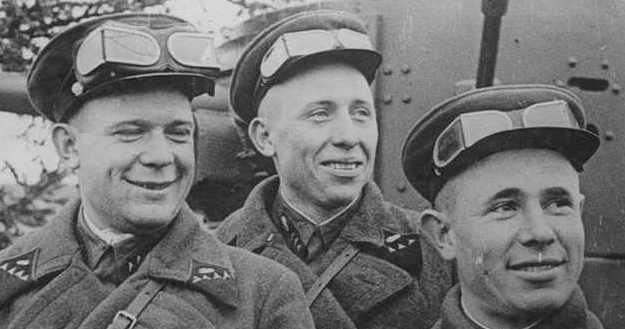
Figure 16. RKKA ‘Protective Goggles’. A heavy course grained leather with thick glass and grey painted or nickel plated steel frame version; was used by RKKA motorised troops from 1934 until early WWII, when leatherette took over. Of all the versions of the type these are the largest, heaviest and rarest. They usually had a simple two piece strap, which tied together at the back. This image is from early 1941.

Figure17. The wartime RKKA design had three variations in the length of the windows to increase peripheral vision or fit the individual soldier’s face. Left, the large ‘long window’ version on a motorcycle-sidecar team. Right, a RKKA tank crew member with the smaller ‘short window’ version.

Figure 18. RKKA versions of the Russian military ‘Protective Goggles’. Top, the course leather version, introduced in 1934, it was used until early WWII when shortages lead to an identical design using vinyl coated cotton canvas. Note the ‘hinge’ is actually a part of the flexible face mask. The same version was issued until 1954, when cheaper versions appear. Note the middle one is a small size with shorter ‘D’- frames.
The pre-war and early war Russian (RKKA) folding lens model was a very heavy leather version, by mid-war an identical version, in fake leather (thin vinyl on heavy cotton canvas) was being produced. For a short while post war the leather version was again produced as safety glasses (see Fig. 19).

Figure 19. Post-war ‘Ministry of Health USSR’ (Министерство ЗДРАВООХРАНЕиЯ CCCP), published by ‘Glavmedprom’ (ГЛАВМЕДПРОМ), ‘Safety Glass’ (ОЧКИ ПРЕДОХРАНИТЕЛЬНЫЕ), catalogue printed in ‘Moscow 1948’. It shows that leather versions of the 1934 pattern were again produced post-war. On the right is shown the two sizes produced at that time No. 1880 was described as ‘Glasses differ, very big field sight’, they have longer windows, it weighed 115 grams. No. 1879 was the standard size and weighed in at 95 grams.
The 1934 type continued to be issued and sold post-war until 1954 when a light-weight version was developed, this was mass produced until the 1970s. The 1954 version (гост 111-54, with Government standards variations in 1961 etc) was mainly a civilian version, for industry and civilian transport use. They may have been used by the military as a non-specialised, lightweight and handy; for occasional use only, general purpose goggle. By this time however, tank crews and others who habitually had to wear goggles were using stronger specialised types. This cheap version had lightweight thin plastic leatherette masks and relatively thin chromed pressed steel frames. They sometimes have a PO-# designation, which is post-war nomenclature, ‘Rabochie Ochki’ – ‘Goggles for Workers’. Earlier versions still had a sewn on hem, but later, even cheaper versions only had zigzag stitching to stop the edges fraying.
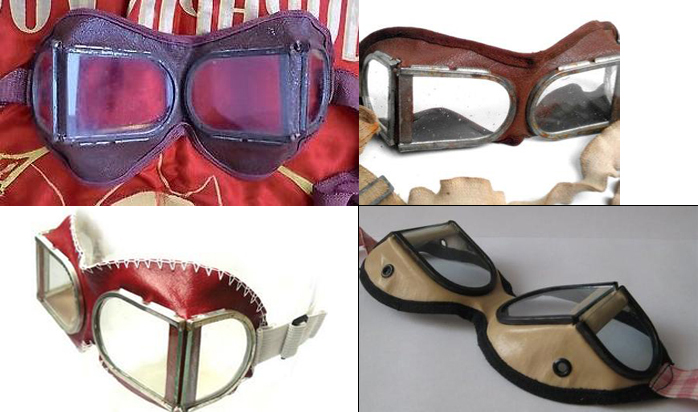
Figure 20. Post-war Soviet, cheap, lightweight versions from 1954 to the 1970’s. They were mainly for industrial use and sold to the general public, often in brighter colours. For ease of construction they usually have flanges (first 3) on the brightly chromed, pressed sheet steel frame. Bottom left, is the cheapest version, with no hem, just zigzag stitching to stop fraying. Bottom right, from the style and materials used it is probably a late pre-1954 model.
Typically on the cardboard box in which they are supplied is written something similar to: –
Figure 21. Germany did not produce or issue split lens goggles during WWII. Here a pair of captured RKKA Protective Goggles are being used by a German machine gunner.
The Chinese Versions
A common post-war version is this Chinese ‘Type 59’, ‘fold(ing) goggles’ (折风镜); also known as ‘sheep skin goggles’ (羊皮风镜). Used as general purpose ‘dust proof’, ‘wind proof’, ‘mountain troop’ and ‘tank goggles’. They may have been designed for, and issued, with the Type 59 tank. A better made version, with padded hem, was made for the Chinese Navy. Adopted in 1959, the standard version was mass produced in the period 1960-1975; these dates coincide with the Sino-Soviet Split, when weapons and equipment were no longer sourced from the Russians; and ends with the end of the ‘Cultural Revolution’ and China’s subsequent modernisation.

Figure 22. The Chinese versions have plain or tinted plastic lenses and a good quality soft sheepskin mask. At top, a bulk carton, middle, tinted version. Bottom, the ‘Navy’ version, with well padded hem. Unlike the Soviet version they have a metal hinge, similar to the war-time Japanese type, as is its leather case (see Fig 14, bottom).
Examples are often found with slips of paper typically saying: –
 They have a quality soft sheepskin leather face mask and tend to come in only dark brown to black. The lenses are plastic, and the brightly chromed (blackened on the ‘Navy’ version) steel frame has a mortise hinge. The fact that they have a hinge and come in a thick leather case to be carried on the belt would seem to imply they are a descendant of the Japanese Type 5 Dust Goggle rather than the Soviet versions. During the 1930s and early 1940s Japanese goggles were certainly produced in the annexed Manchuria, with some of the aviators ‘Eagle Eye’ goggles carrying the ‘MAN’ (for Manchuria) logo. It is not known if the Type 5 Dust Goggle was also produced there, but the Chinese resurrection of a similar design years later may hint that they were?
They have a quality soft sheepskin leather face mask and tend to come in only dark brown to black. The lenses are plastic, and the brightly chromed (blackened on the ‘Navy’ version) steel frame has a mortise hinge. The fact that they have a hinge and come in a thick leather case to be carried on the belt would seem to imply they are a descendant of the Japanese Type 5 Dust Goggle rather than the Soviet versions. During the 1930s and early 1940s Japanese goggles were certainly produced in the annexed Manchuria, with some of the aviators ‘Eagle Eye’ goggles carrying the ‘MAN’ (for Manchuria) logo. It is not known if the Type 5 Dust Goggle was also produced there, but the Chinese resurrection of a similar design years later may hint that they were?
RAF War-Time ‘Split Lens’ Designs
In Britain the RAF entered the Second World War with an unpopular goggle type, the Mk III (and IIIa which had less padding). It’s unpopularity was due to the fact it had curved plastic lenses which, it was claimed, distorted the view and scratched and scuffed easily. Many pilots did not wear goggles as a result, or preferred the 1928-33 Mk II which, apart from the strap, was near identical to the Triplex ‘Feather Weight’ goggles of 1916; or various private purchase pairs similar to the Mk II or Luxor types etc. Although cockpits were fully enclosed by this time, inverted or negative ‘G’ flying would cause debris to become airborne in the cockpit causing eye irritation and injuries, as did any damage to the canopy; worst of all there were mounting numbers of facial burns causing serious eye injuries. The RAF rushed to develop a goggle type that young headstrong pilots would actually wear once airborne.
As the main complaint about the Mk III was its curved plastic lenses, this aspect was tackled first. As plastic does scratch and scuff easily and the prevailing attitude to plastic was negative, due to memories of early flammable celluloid lenses, the idea of using any form of plastic was dispensed with immediately. Curved glass lenses increase peripheral vision, but are relatively expensive and tend to distort sight. Depending on quality, curved glass lenses will always cause, to some degree, errors in exact object location, and more importantly, cause eye fatigue and visual discomfort. These factors are compounded by increasing the glass thickness.
Curved lenses are usually cut from cylinders of glass; the resulting lenses have an inherent ‘spherical aberration’ and can also have manufacturing variables such as ‘radius errors’ and irregularities in thickness. The two sides of the lens are not easily polished to an identical optical quality radius and flatness. Curved glass, which for optical reasons has to be kept as thin as possible to stop them acting as lenses (in the true sense), is not easily made safe by laminating.
Only a couple of curved laminated glass goggle designs were made during WWII, most famously the Japanese ‘Eagle Eye’ goggles. The Germans produced special ‘Armoured Glass’ goggles in modest numbers, with curved laminated glass lenses. The other standard German aviation goggles i.e. 295 and 306 were curved single layer glass, as was the American AN6530 and its predecessors. Although these had a good field of view and deflected wind, small debris and flames, the single layer of brittle glass often inflicted horrendous eye injuries when struck with any force. The Americans changed to easily replaceable plastic lens goggles in October 1943 (the B-8 and its derivatives by Polaroid); the Germans produced the Nitsche & Gunther ‘Anti-Splinter’ goggles, these had small curved lenses, designed to be tough. They could be worn under the 295 type. That they were not entirely effective is evidenced by the introduction of the larger laminated ‘Armoured Glass’ goggles to selected air crews.
Flat glass is very cheap and is easily polished to optical quality, so it does not appreciably distort vision across any part of the view, no-matter how thick it is. It is easily laminated; a huge safety advantage hence the choice of laminated glass ‘armoured’ goggles for tank crews by Britain, the USA and Japan in the 1930s/WWII. Flat lenses, however, sit near perpendicular to the site line, surrounded by a flat frame so peripheral vision is always limited by the frame and cups/padding. This had always been a criticism of the old RAF Mk II, which was otherwise well liked as being simple, sturdy, optically excellent and, above all, safe. As stated by Prodger (1995), it is probable that someone remembered the excellent field of view associated with the private purchase split lens goggles of early WWI which, although being flimsy, had the excellent optics of flat glass, combined with good peripheral vision. As such split-lens laminated flat glass was the basis of the Mk IV goggles issued in June 1940. Some, but not many were in time to be employed in the Battle of Britain.

Figure 25. Some major WWII aviation goggle lenses compared. Bottom Luftwaffe 295, thick curved single layer. 2nd from bottom, US AN6530 (tinted), thick curved single layer. 2nd down, Japanese ‘Eagle Eye’, thin curved laminated glass. Top. RAF Mk IV, thick flat laminated glass.

Figure 26. The first new design of goggle for the RAF in WWII, the Mk IV. That its ancestry was the earlier folding split lens goggle types is perhaps best shown by the hinged ‘window’ frames of the first Mk IV model. As they were supposed to be worn continually by pilots the concertina fold-ability of the earlier soft mask versions was deliberately missing. The ‘lenses’ were officially called ‘windows’ by the RAF; as the term lens intrinsically implies a distortion of light in some way. (image www.historicflyingclothing.com)
Although the Mk IV’s split windows addressed the curved lens issues of distortion, safety and price; and the peripheral vision issues of single piece flat lenses; they were complex and heavy. The Mk IVa (lighter, plastic framed), and Mk IVb (going back to brass frames, addressing strength issues with the IVa) both had the split windows issued as a single pre-constructed unit doing away with the hinge. As all the Mk IV models were complex, simplification came as the Mk VII issued in July 1942 and then in April 1943 the Mk VIII (N.B. Mk V and VI were spectacles/sunglasses). Although the obvious difference between the Mk VII and Mk VIII was simplification, an important change not often mentioned was the cushion stuffing, the Mk VII (and Mk III) had used an early kind of foam rubber, which hardened relatively quickly when in contact with the natural oils found in leather, leaving the cushions completely solid or sometimes breaking up into a grit like substance. The Mk VIII had kapok stuffing, a natural cotton wool like substance, which stays flexible indefinitely.
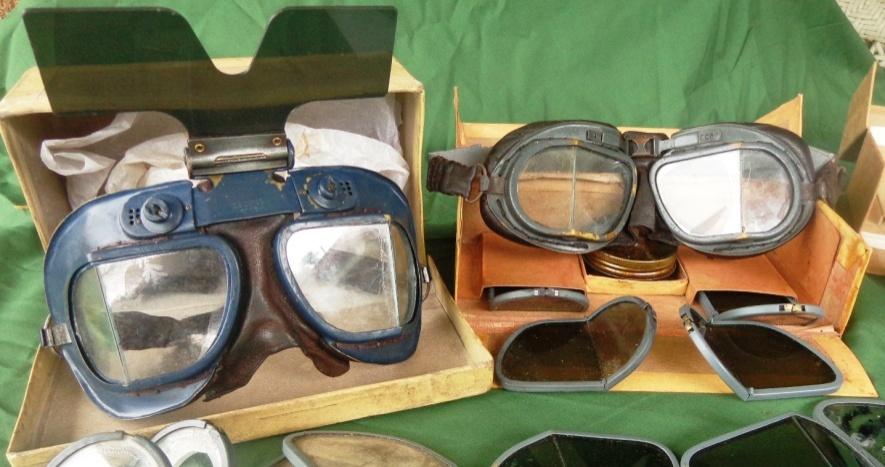
Figure 27. Mk VII goggles left and Mk VIII right. In the foreground are spare ‘windows’ showing how the two panes were housed in a light mount. Tint changes were simply done by unclipping the small metal strap-tongue and pushing the lens inwards to remove it and doing the reverse to install a new lens (sorry ‘window’!).

Figure 28. RAF split lens laminated ‘windows’. Centre, First Mk IV ‘windows’; separate pieces of laminated glass. Left, Mk IVa & IVb, glass is sitting on a brass sheet frame and held by small bent tabs, less fiddly than separate pieces, but still weak and easily flattened or broken when not in the main frames. Right, Mk VII & Mk VIII, the glass is now held in a ‘U’ section piece of brass channel, these could withstand rough storage and repeated changes. Back ground L-R; US AN6530; Luftwaffe 295; Japanese ’Eagle Eye’.
The Mk VIII, introduced in April 1943 was on RAF stores lists until the 1970’s, said to have been available for when flying historic aircraft and when ‘posing in sports cars’. British companies such as Stadium/Halcyon made copies of it through the 1950’s to the present day and many companies around the world such as EMGO and several ‘generic’ firms are still producing clones.

Figure 29. U.S. airmen of the 8th Bomber Command and 80th Fighter Group choose to wear RAF Mk VII’s and MkVIII’s respectively. As did many other US air crews based in Europe.
An Italian Split lens Model
Ratti had been producing goggles since 1917, the ‘Protector’ label had been developed in 1918 and continual developments had seen these lightweight quality goggles used by Italian racing drivers and aviators through the 1930’s. They were popular with pre-war German racing drivers, with a model called the ‘Dictator’ available (this name was missing from post war catalogues!) In the war, as the M38 and M42, they were standard issue Italian military goggles. With their simplicity and light weight they became popular with both the Germans and Allies in North Africa. For the same reason these, and the Czech (or Sudetenland) ‘Duchrow’ goggles, were often preferred by German Paratroopers, over the complex German types. All the pre-war and war time models, however, were not split lens types. Post-war RAF Mk VIII’s became common on the racing circuit; in response Ratti produced a neat and fashionable split lens ‘Protector’ model as an answer to the war surplus goggles which were flooding the market.

Figure 29. Post-war Italian ‘Protector’ laminated split lens goggles, by Ratti. Here worn by racing driver Fangio in the early 1950s. Also produced with dark tinting as ‘Persol’ -‘for the sun’.
British, Protectors Eye ‘Anti-Mine’. 1960s-70s

Figure 30. ‘Protectors Eye. Anti-Mine’. British army bomb disposal – anti-mine goggles, from the 1960’s and1970’s. These have very thick laminated glass and heavy frames with side windows for good peripheral vision, they are not foldable.
Modern Versions

Figure 32. Post War Mk VIII clones started to be produced almost immediately by several companies; Stadium being best known. Left Stadium Mk VIII these have a different strap arrangement and finish to RAF goggles, they also have ‘Made in England’ on them which military issue items do not. Centre a pair with Stadium designed barrel screw adjuster across the bridge, called the Mk 9 (definitely not an RAF designation). Right, Halcyon, a components supplier to Stadium, took over goggle production when Stadium ceased that line of product. They are still produced today, shown here are a smaller ‘Compact’ pair, with the Stadium barrel screw adjustment.
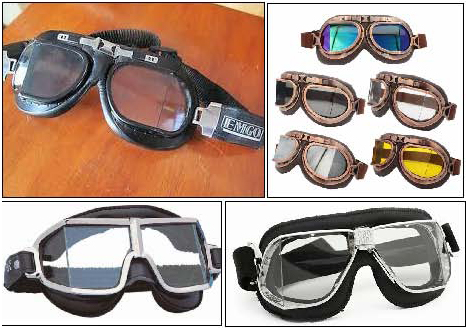
Figure 33. Other current manufacturers. Top left, a pair sold by the US company, EMG0. Top right, generic examples from China. Bottom right, split lens goggles by the Spanish company Climax. Bottom left, by the Italian company Nannini.
How to Identify?
The pre-WWI split lens versions come in many styles and materials. At that time there were no international patents or international registered trademarks. This combined with the fact that most towns would have small business and workshops that could easily produce items such as goggles, means that identification of the provenance of these early ones is difficult. Some may have the country of manufacture written on them or their case, or have clues. ‘Brevet’ or ‘Brevete’ is the French for Patent; ‘DRGM’ is an Imperial German registration mark. DEP, Depose or Depontiert is a German word for ‘registered’ or ‘copyright’, but is also found on French items. Some French brands such as OTO/ JBJ tend to have fleur-de-lis on the strap slider, or logo’s on the strap tag or case; often a nice little balloon. Patent, Pat. or Pat’d etc, are usually British or US, ‘Pat. Pending’ is generally US; if you have a patient number it is usually a formality these days to find the items details on the internet.
Early frame types were often made of brass, or nickel plated steel. Chrome did not become common until the very late 1920s.
The early Japanese versions may be indistinguishable from European produced ones; however they always seem to have mortise hinges, Western ones use both metal hinges and fabric joints. If they come in the leather case as shown in Fig. 14, it’s a good chance they are Japanese. Sometimes they will have the place of manufacture written on them or a kana military acceptance stamps inside the mask. The War-time khaki canvas ones should be unmistakable (see Fig 11).
The Russian (RKKA until 1946, Soviet Army after) goggles of 1934 to 1954 are large and heavy (see Fig. 18). Post 1954 they are lightweight and cheap looking, with lightweight leatherette and ‘flanged’ frames (see Fig 20) and where usually for non-military purposes.
The main way to tell whether post war models are Eastern European or Chinese is in the hinge design. The Chinese version appears to have evolved from the Japanese Dust Goggle of WWII, this can be seen in both the smart leather case and the hinge design. Both the Japanese and Chinese versions have a mortise hinge, with a wire pin passed through the interlocking metal teeth. The Chinese ones have quality leather masks, but plastic lenses. The Russian types only used the material of the mask as the hinge joint and post early WWII the masks are made of leatherette and become thinner as time goes by, but always have glass lenses.
Steve Saunders
March 2017
Addendum
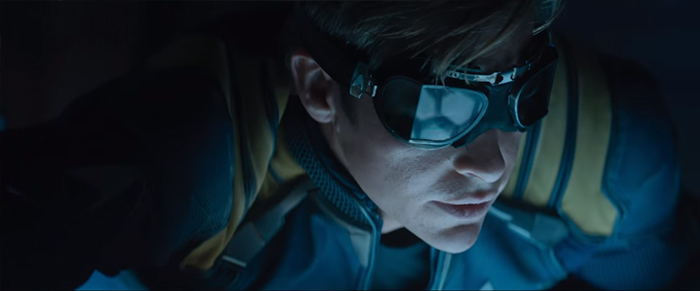
Introduced in April 1943, RAF Mk VIII goggles still being used 320 years later!, January, 2263 (Star Date 2263), by Capt. James T. Kirk of the USS Enterprise.
Still from Justin Lin’s ‘Star Trek Beyond’ (2016), Paramount.
Acknowledgements
Aleks and Dmitri at Espenlaub Militaria, http://www.aboutww2militaria.com, helped greatly with questions on the Soviet types.
‘Beijing’ Ben, http://sidecarpro.com/ helped with details of the Chinese Types.
Bibliography
Mick J. Prodger (1995), Aviation Headgear Before The Jet Age.
http://www.warrelics.eu/forum/japanese-militaria/what-tank-goggles-663214/









This is what I was looking for. The first time I saw this type of goggle was on a video with Adam Savage. He was wearing the goggles over his glasses, so I had to find a pair for my self. This article was really fun to read, and now I know what key words to use when searching the web. I just wish I knew where I could find a modern reproduction. I’m definitely going to browse your other articles for fun facts about military gear.
Hi Emma, glad to be of use.
Just look on eBay for Russian Goggles, should bring up some. Under $20 usually. The Chinese ‘sheep skin goggles’ are probably twice the price, better made, but only have plastic lenses.
Good luck,
Steve
I would like to know where can I get replacement clear lenses?
They occasionally come up on ebay, old Chinese military surplus. But lenses on their own are rare. You might have to buy a new pair of goggles for $30 – 40., which sometimes have spare lenses with them.
Regards
Steve